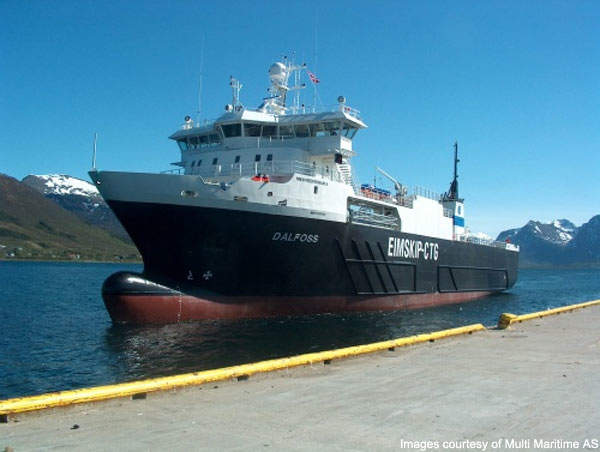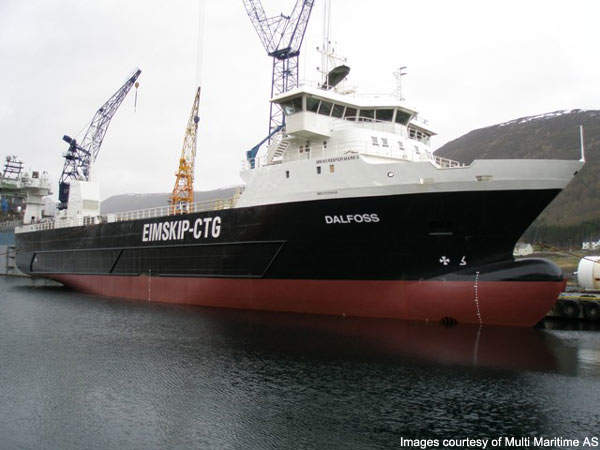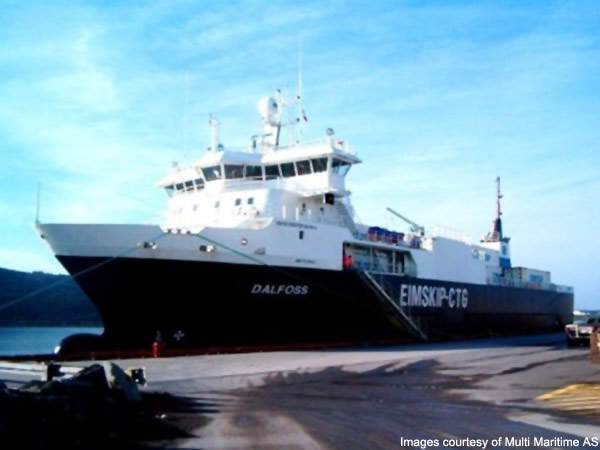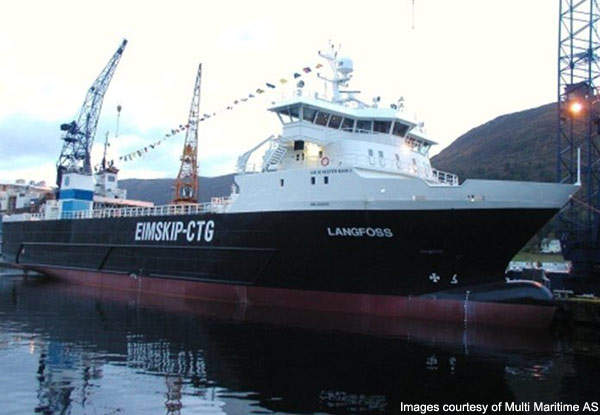The Dalfoss reefer, registered in Antigua and Bermuda, is the third of a series of four ships constructed for Eimskip HF of Iceland for the shipping of perishable cargos, which require temperature-controlled transportation.
The Dalfoss was delivered to Eimskip in May 2007. In September 2007 its sister ship the Langfoss was also delivered. Two more ships – Holmfoss and Polfoss – were delivered in early 2008. Dalfoss can carry out reefer activities and is also able to transport containers and pallets if required.
The vessels have been specially designed to operate with general reefer cargos in exposed sea areas with relatively high-speed operation of around 16kts.
The ship was constructed by Myklebust Verft AS of Norway at the Kherson Shipyard and was designed as an MM 80 Reefer MK II by Multi Maritime AS.
The ship is classified as DNV +1A1, Reefer (-27°C/+32°C), Container, Ice 1A, EO, which indicates that it is an Ice class 1A vessel able to operate in ice that is 1m thick.
The ship’s maiden voyage was in July 2007, to Canada’s Port of Argentia to pick up 800t of frozen fish product.
Features
The Dalfoss reefer can handle dry cargoes with individual temperature control in each cargo hold. Temperatures can be as low as -27°C.
The vessel has five holds on three decks and can also handle transport containers and refrigerated containers on the open deck. Loading and unloading is carried out by forklifts in the cargo holds and two cargo lifts operating between the cargo deck levels and quay level. There are also side ports opening onto the quay. The total hold volume is 5,568 m³. Discharging capacity is 200t per hour.
Dimensions
The ship has an overall length of 79.99m with a perpendicular length of 78.15m. The moulded breadth of the ship is 16m and the depth to the shelter deck is 9.10m. The scantling draught is 6.10m and the design draught is 5.75m. The gross tonnage of the ship is 3,500 GRT and the deadweight is 2,500t. The ship has a container capacity on the boat deck of 28ft × 40ft containers or 1,800 pallets.
Facilities
There is a crew capacity of 11, with accommodation divided into nine single cabins and one double cabin. In addition, there is a mess, smoker’s salon, changing room, trim room, sauna, galley, freezing/refrigerated room for food storage and laundry facilities. There is one six-person ‘man over board boat’ with a 40 horsepower outboard engine. There are also two twelve-man liferafts on each side.
Refrigeration Plant
The cargo holds are cooled by the use of gravity air circulating cooling coils that are installed under the deck. The coils were designed for the pump circulation of calcium chloride. The refrigerating machinery system consists of two automatic Brine Chiller Units. Each unit is equipped with a screw compressor, electric motor, shell and tube condenser and a plate-type brine chiller. The refrigerant used for these systems is R717.
Engines and generators
The main engine on the vessel is a diesel capable of generating 2,970kW at 600 RPM (Caterpillar Motoren GmbH & Co KG). The ship has a 4,000mm propeller (CP, 133RPM) (Finnøy Gear & Propeller AS) and the steering gear is a Hinze flap rudder. There are two side thrusters forward and aft of 500kW and 350kW respectively (UF63 LTC-1550 and UF 45 LTC-1375). There are two 738 kVA, 1,800 rpm (450V 60Hz) generators (Caterpillar Inc 3412) and also a shaft generator (G70) of 1,200 kVA, 1,200 rpm (3×440V, 60Hz).
Navigation
There are two radars (3/10 cm), ARPA, DGPS, GPS, AIS, electronic chart system, voyage recorder, gyro compass, magnetic compass, autopilot, echo sounder, speed log and closed circuit TV monitoring system. The communication systems include GMDSS radio, GMDSS VHF, VHF, Navtest receiver, telefax, GMS phones, UHF and TV satellite antenna.







